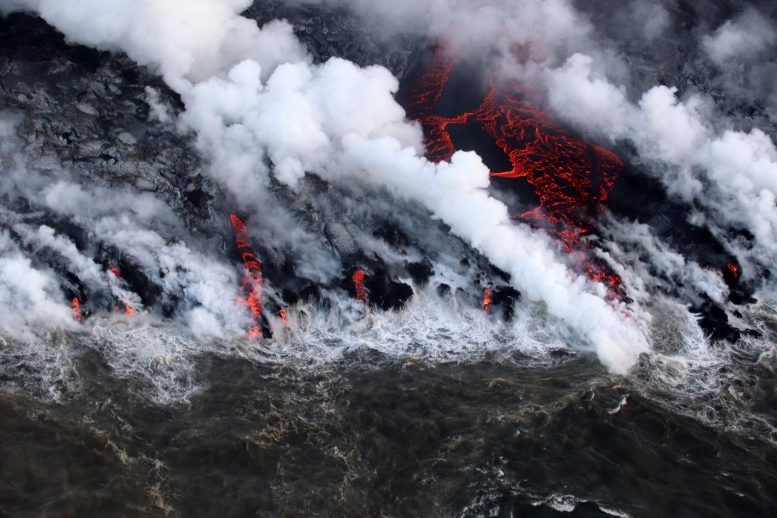
A lava flow from Hawaii’s Kilauea Volcano enters the ocean near Isaac Hale Beach Park on August 5, 2018. The volcano’s 2018 eruption was its largest in over 200 years. Credit: USGS
Caldera Collapse Increases the Size and Duration of Volcanic Eruptions
Scientists have figured out what triggers large-scale volcanic eruptions and what conditions likely lead to them.
Hawaii’s Kilauea is one of the most active volcanoes in the world. Because of this and its relative ease of accessibility, it is also among the most heavily outfitted with monitoring equipment – instruments that measure and record everything from earthquakes and ground movement to lava volume and advancement.
Kilauea’s 2018 eruption, however, was especially massive. In fact, it was the volcano’s largest eruption in over 200 years. Scientists at NASA’s Jet Propulsion Laboratory in Southern California used the abundance of data collected from this rare event to shed light on the cause of large-scale eruptions like this one and, perhaps more importantly, what mechanisms trigger them.
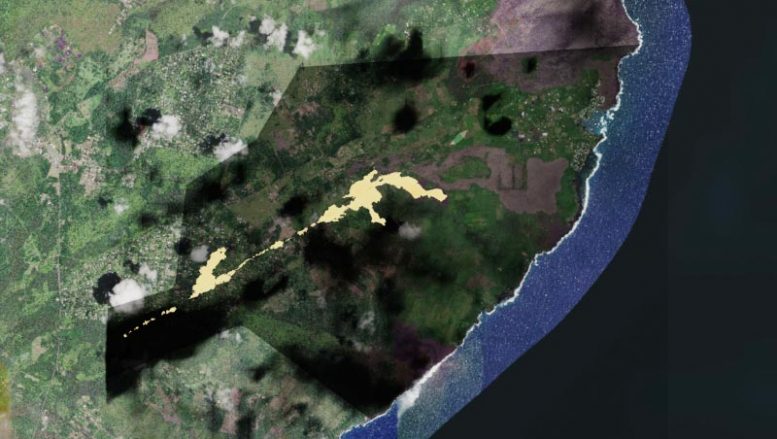
This image shows the lava flow from the 2018 eruption of Kilauea prior to the collapse of the caldera. Credit: NASA/JPL-Caltech
“Ultimately, what caused this eruption to be so much larger than normal was the collapse of the volcano’s caldera – the large, craterlike depression at the volcano’s summit,” said JPL’s Alberto Roman, lead author of the new study published recently in Nature. “During a caldera collapse, a massive block of rock near the top of the volcano slides down into the volcano. As it slides, gets stuck on the jagged walls around it, and slides some more, the block of rock squeezes out more magma than would ordinarily be expelled.”
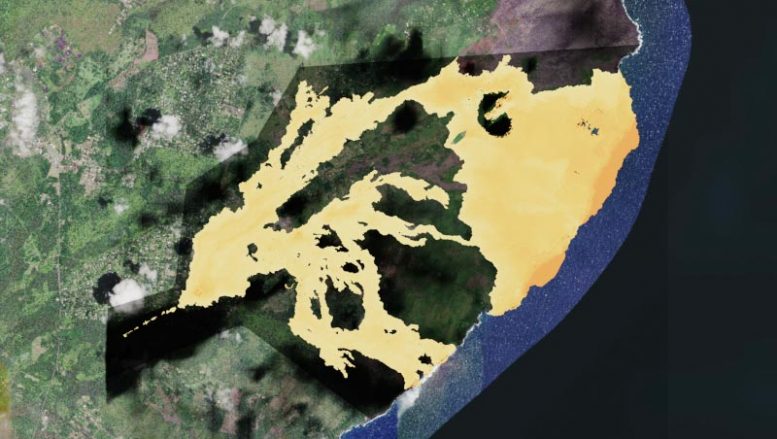
This image shows the much larger lava flow that followed the collapse of the caldera. Credit: NASA/JPL-Caltech
But what the science team really wanted to know was what caused the caldera to collapse in the first place – and they found their answer.
The likely culprit? Vents – openings through which lava flows – located a distance away from, and at a much lower elevation than, the volcano’s summit.
“Sometimes, volcanoes erupt at the summit, but an eruption can also occur when lava breaks through vents much lower down the volcano,” said JPL’s Paul Lundgren, co-author of the study. “Eruption through these low-elevation vents likely led to the collapse of the caldera.”
During an eruption, the surface of a volcano deforms, or changes shape. The color bands in the lower-right animation box show those changes from before to midway through Kilauea’s 2018 eruption. The closer the color bands are to one another, the more severe the deformation in that area – much like the contour lines on a topographic map denote rapidly changing altitude. Credit: NASA/JPL-Caltech
Lundgren compares this type of vent to the spigot on a collapsible water jug you’d take on a camping trip. As the water level drops toward the location of the spigot, the flow of water slows or stops. Likewise, the lower down the volcano a vent (or “spigot”) is located, the longer lava is likely to flow before reaching a stopping point.
A large quantity of magma can be expelled quickly from the chamber (or chambers) beneath the volcano through these vents, leaving the rocky floor and walls of the caldera above the chamber without sufficient support. The rock from the caldera can then collapse into the magma chamber.
As the rock falls, it pressurizes the magma chambers – for Kilauea, the research team identified two of them – increasing the magma flow to the distant vents as well as the total volume of the eruption. The pressurization is akin to squeezing the water jug to force out the last little bit of water.
After developing their model of these eruption processes, taking advantage of the myriad data available from Kilauea, they also compared the model’s predictions to observations from similar eruptions driven by caldera collapse at other volcanoes. The results were consistent. Even though the model doesn’t predict when a volcano is going to erupt, it can provide crucial insight into the likely severity of an eruption once it begins.
“If we see an eruption at a low-elevation vent, that is a red flag or warning that caldera collapse is possible,” said Roman. “Similarly, if we detect earthquakes consistent with the slipping of the caldera rock block, we now know that the eruption will likely be much larger than usual.”
Reference: “Dynamics of large effusive eruptions driven by caldera collapse” by Alberto Roman and Paul Lundgren, 14 April 2021, Nature.
DOI: 10.1038/s41586-021-03414-5


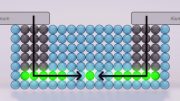
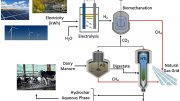



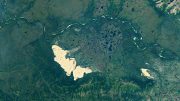

Very impressed. This can possibly help to predict arruction.
Bonjour….merci….
That’s only a symptom your expressing ! NOT THE CAUSE !
You have NOT considered the added weight to continents by allowing seismic testing around the world, That ultimately impedes ground water drainage
This holds back water that adds millions and billions of tons of weight to every continent that they have done seismic testing on, It takes only one continent to offset the balance of equilibrium around the world,
This added weight puts pressure on ALL continental seams all around the world,
Your describing a typical land slide within a chamber. Shift the height move the magma under a hole that was prehistorically made, and sure your going to get funny effects as you mentioned, Stop looking at symptoms and look for the actual cause, Continental sinking, continental tilt or continental shifting in any direction will cause volcanic actions, External gravitational pressures even from the Sun and other planetary movements.
You got a long way to go before you actual know what causes said
More NASA mission creep! Why is the Jet Propulsion Laboratory investigating Earth volcanoes? Money being spent on projects like this, which is the purview of the US Geological Survey, is why we haven’t been back to the moon in almost 50 years, and why Elon Musk may put humans on Mars before NASA does. NASA routinely usurps research that the USGS and NOAA are staffed — and have the specialized equipment — to perform. It is a waste of taxpayer’s money to duplicate effort.
Honestly, this is a nothing burger. This kind of thing happens all over the place, in all sort of solid/fluid dynamic scenarios. What they’re saying is they just were too dumb to figure it out before.
The thing is that such massive scale eruptions predictions would not benefit greatly because the effects are worldwide and catastrophic so I don’t know what can we really do to prepare for this
Lol we already have a base on the Moon AND Mars already, since 1963 (or 53…well it’s there anyway).
Maybe that Elon guy who’s cars keep crashing will be the guy who sends people to Europa or that other moon. Definitely interesting stuff for sure tho
How ‘bout you just don’t live in proximity to a volcano?
It appears that the employees at JPL and NASA have deviated from their assigned tasks, i.e. SPACE TRAVEL/EXPLORATION.
Well duh.
High heat and pressure within the earth’s core and fissures in the earth’s mantle and crust cause volcanoes, am I right?
I lived on Kilauea Volcano in 2018. JPL has this event backwards. THere was a 6.4M earthquake, then the East Rift vent opened at 350′ above sea level – in a populated area. THen the magma rushed down the rift and broke out in 24 locations along the rift. THen the caldera collapsed into the empty chamber, the surface falling from 4000′ to 1500′ elevation. This JPL person is just wrong.